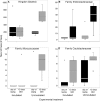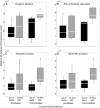Avian incubation inhibits growth and diversification of bacterial assemblages on eggs
- PMID: 19225566
- PMCID: PMC2639702
- DOI: 10.1371/journal.pone.0004522
Avian incubation inhibits growth and diversification of bacterial assemblages on eggs
Abstract
Microbial infection is a critical source of mortality for early life stages of oviparous vertebrates, but parental defenses against infection are less well known. Avian incubation has been hypothesized to reduce the risk of trans-shell infection by limiting microbial growth of pathogenic bacteria on eggshells, while enhancing growth of commensal or beneficial bacteria that inhibit or competitively exclude pathogens. We tested this hypothesis by comparing bacterial assemblages on naturally incubated and experimentally unincubated eggs at laying and late incubation using a universal 16S rRNA microarray containing probes for over 8000 bacterial taxa. Before treatment, bacterial assemblages on individual eggs from both treatment groups were dissimilar to one another, as measured by clustering in non-metric dimensional scaling (NMDS) ordination space. After treatment, assemblages of unincubated eggs were similar to one another, but those of incubated eggs were not. Furthermore, assemblages of unincubated eggs were characterized by high abundance of six indicator species while incubated eggs had no indicator species. Bacterial taxon richness remained static on incubated eggs, but increased significantly on unincubated eggs, especially in several families of Gram-negative bacteria. The relative abundance of individual bacterial taxa did not change on incubated eggs, but that of 82 bacterial taxa, including some known to infect the interior of eggs, increased on unincubated eggs. Thus, incubation inhibits all of the relatively few bacteria that grow on eggshells, and does not appear to promote growth of any bacteria.
Conflict of interest statement
Figures



References
-
- Clutton-Brock TH. The evolution of parental care. Princeton, NJ: Princeton University Press; 1991.
-
- Board RG, Fuller R. Non-specific antimicrobial defences of avian egg, embryo and neonate. Biol Rev. 1974;49:15–49. - PubMed
-
- Board RG, Fuller R, editors. London: Chapman and Hall; 1994. Microbiology of the Avian Egg.
-
- Korpela JK, Kulomaa MS, Elo HA, Tuohimaa PJ. Biotin-binding proteins in eggs of oviparous vertebrates. Experientia. 1981;37:1065–1066. - PubMed
-
- Engel S, Jensen PR, Fenical W. Chemical Ecology of Marine Microbial Defense. J Chem Ecol. 2002;28:1971–1985. - PubMed
Publication types
MeSH terms
LinkOut - more resources
Full Text Sources
Medical
Molecular Biology Databases

